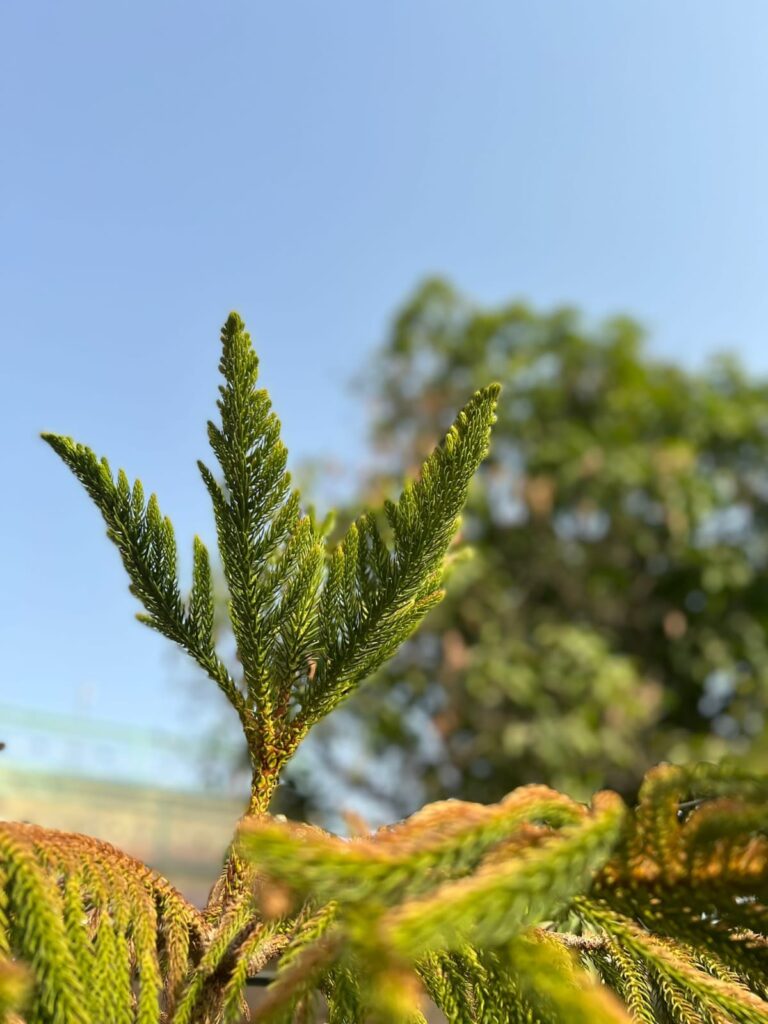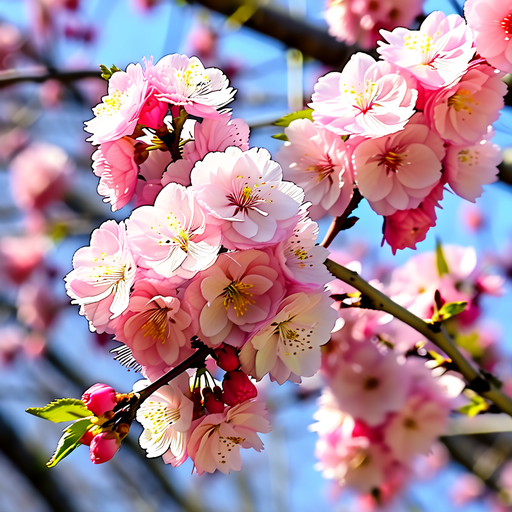What is An Ornament Trees And Benefits of Ornamental Trees:
Updated: 02/03/2024
56

What is An Ornament Trees?
Ornament trees are specifically grown purely for their visually appealing features. Whilst many fruit trees can be planted ornamentally, not primarily grown for their fruit.
Generally, ornamental trees can be categorized into one of three categories:
1. Weeping Trees: are categorised which have drooping foliage and soft branches, such as the Himalayan Fur Pine and the Willow Tree.
2. Structural Trees: are trees which are valued for their unique shapes and forms, regardless of size. They can be large or small – just as long as they are enjoyable to look at!
3. Flowering Trees: are perhaps the most popular type of ornamental tree, are also known for their vibrant blooms, and the name is pretty self-explanatory. These trees burst into bloom with beautiful flowers.
Benefits of Ornamental Trees:

Ornamental trees are not just beautiful additions to our landscapes; they also provide many benefits that increase our surroundings and well-being.
One of the most notable advantages of ornamental trees is their ability to make better air quality by absorbing pollutants and escaping oxygen, contributing to a healthier environment for both humans and wildlife.
Furthermore, these trees can act as natural sound barriers, decrease noise pollution in urban areas and create serene, peaceful spaces for relaxation.
In addition to environmental benefits, ornamental plants offer aesthetic value through their different colors, shapes, and structures, adding visual interest to gardens and public areas.
Their seasonal changes bring energetic transformations all through the year, creating ever-evolving landscapes that raise moods and impressive creativity.
Moreover, ornamental trees can attract beneficial wildlife such as birds and pollinators, fostering biodiversity within ecosystems while giving us opportunities for observation and connection with nature.
With their multiple advantages surrounding environmental health, aesthetics, and habitat support, ornamental trees no doubt play an important role in increasing our living environments.
These are the following benefits of ornamental trees
1. Aesthetics in landscaping:
- When it comes to the art of landscaping, aesthetics play a vital role in creating an environment that is not only visually appealing but also harmonious with nature.
- Ornamental trees are essential elements in achieving this balance, as they contribute unique shapes, colors, and structures to the landscape.
- Whether it’s the graceful silhouette of a weeping willow or the vibrant blooms of a cherry blossom tree, each ornamental tree has the power to upraise the overall aesthetic of any outdoor space.
- In addition to their visual appeal, ornamental trees also offer a sense of tranquillity and beauty that can increase the environment of any garden or outdoor setting.
- The careful selection and placement of these trees can create focal points, frame views, and add depth and dimension to a landscape.
- By including a variety of shapes and sizes, landscapers can craft dynamic compositions that draw the eye and inspire wonder.
- Ultimately, aesthetics in landscaping are about more than just creating something pretty, they’re about using nature’s beauty as a tool for shaping our surroundings into spaces that evoke emotion and connection.
2. Seasonal Interest and Colour Variations:
- Seasonal interest and colour variations are among the most exciting reasons to include ornamental trees in your landscape.
- These trees offer a stunning display of changing foliage all through the year, from vibrant flowers in spring to rich, fiery hues in autumn.
- The dynamic transformation not only adds visual interest but also creates an ever-changing backdrop for your outdoor space, making it feel alive and all the time evolving.
- Furthermore, the different range of colours offered by ornamental trees can enhance the overall aesthetic appeal of any garden or landscape.
- From the delicate pastels of flowering cherry trees to the bold reds and oranges of Japanese maples, these trees provide an arrangement of options to suit different design preferences.
- By strategically planting a variety of ornamental trees with staggered flower times and complementary colour palettes, you can create a visually captivating environment that is involved with each passing season.
- This not only adds depth and dimension to your landscape but also sparks joy and delight as you witness nature’s ever-changing artwork unfold before your eyes.
- In addition to their impressive seasonal displays, ornament trees also contribute to ecological diversity by attracting pollinators and providing shelter for wildlife all through the year.
- This important role further underscores their value beyond mere aesthetics, making them invaluable benefits in any sustainable landscaping effort.
- By hold the beauty of seasonal interest and colour variations offered by ornamental trees, you can infuse your outdoor space with an charming allure that celebrates nature’s perpetual cycle of change.
3. Environmental Benefits: Shade, Oxygen, and Habitat:
- Ornamental trees, often appreciated for their aesthetic beauty, offer an excess of environmental benefits that are often overlooked.
- The shade provided by these trees not only offers a break from the extremely hot sun but also helps in reducing energy costs by keeping the surrounding areas cooler.
- Furthermore, the existence of ornamental trees contributes to an increase in oxygen levels within their surrounding area, thereby improving air quality and helping healthier living conditions for both humans and wildlife.
- In addition to providing shade and increasing oxygen levels, ornamental trees serve as important habitats for many species of birds, insects, and small animals.
- These trees produce a growing ecosystem that supports various wildlife populations while adding natural beauty to urban landscapes.
- By protecting these natural habitats through the planting of ornamental trees in public spaces and gardens, we can actively contribute to help biodiversity and foster a deeper connection with nature in our communities.
Popular Varieties for Different Climates
When it comes to choosing ornamental trees for different climates, there are many popular varieties that proceed in specific conditions. In warm and dry climates, the Mediterranean Cypress (Cupressus sempervirens) stands out for its resilience and elegant columnar shape. This evergreen tree adds a touch of sophistication to any landscape while withstanding heat and drought with ease.
On the other hand, in cooler and wetter regions, the Japanese Maple (Acer palmatum) shines with its impressive foliage and adaptability to different soil types. Its delicate leaves turn vibrant shades of red, orange, or yellow in the fall, increasing the beauty of any garden.
For those occupied in temperate climates with moderate winters and moderate rainfall, the Flowering Dogwood (Cornus florida) is a top choice. This deciduous tree not only exhibits beautiful flowers in early spring but also boasts striking red berries that attract birds during autumn. Its multi-season interest makes it a romantic addition to gardens in many temperate zones.
By understanding which ornamental tree varieties flourish best in different climates, gardeners can make informed choices that result in flourishing landscapes all through the year round.
1. Flowering Cherries for Spring Beauty:
- There’s something undeniably magical about the entry of spring, and some things capture its brief beauty fully like flowering cherries.
- These ornamental trees burst into a breathtaking display of delicate blossoms, decorate the landscape with their delicate charm. From the traditional Yoshino cherry to the vibrant pink flowers of Okame cherries, each variety brings its own unique attraction to the springtime tableau.
- But further on their aesthetic appeal, flowering cherries also play an important role in supporting pollinators.
- As bees and other beneficial insects bounce from flower to flower, these trees provide an essential cause of nectar and pollen, contributing to the health and diversity of local ecosystems.
- Additionally, their seasonal spectacle offers a sense of renewal and cheerfulness after the drabness of winter, serving as a touching reminder of nature’s capacity for rejuvenation.

2. Japanese Maples for Fall Foliage:
- As the air turns crisp and the leaves start their breathtaking changing, it’s hard not to notice the extraordinary beauty of Japanese maples.
With their delicate , lacy leaves in shades of bright reds, oranges, and yellows, these ornamental trees are a party for the eyes during the fall season.
- What sets Japanese maples apart is not only their striking colours but also their unique leaf shapes and structures which add an extra size to any landscape.
- One of the captivating aspects of Japanese maples is the way in which their foliage changes all over the fall. While few varieties burst into burning hues of crimson and gold, others take on a more dull yet equally charming palette.
- This diversity offers endless chances for creating visually captivating landscapes that are involved with each passing day.
- Their capacity to grow in containers also makes them versatile options for adding bursts of color to patios, balconies, and small gardens, making them a lovely addition to any outdoor space.

3. Evergreen Magnolias for Year-Round Interest:
- Evergreen magnolias are a stunning addition to any landscape, offering year-round interest with their lush, glossy foliage and fragrant blooms.
- Their elegant and timeless appearance makes them a popular choice for adding beauty and charm to gardens and outdoor spaces.
- Unlike deciduous trees that shed their leaves in the fall, evergreen magnolias maintain their greenery throughout the year, providing constant colour and texture no matter the season.
- In addition to their aesthetic appeal, evergreen magnolias serve as excellent privacy screens or windbreaks due to their dense foliage.
- Their large, showy flowers add a touch of elegance to the surroundings while emitting a delightful fragrance that attracts pollinators like bees and butterflies.
- As versatile ornamental trees, evergreen magnolias can be incorporated into various styles of landscaping designs from formal gardens to natural woodland settings making them an ideal choice for adding year-round interest to outdoor spaces.
- Whether planted as a focal point or used as part of a mixed border, these iconic trees bring timeless beauty and enduring appeal to any garden or landscape.
Planting and Maintenance Tips
Planting and maintaining ornamental trees can be a rewarding experience that enhances the beauty of any landscape. When it comes to planting, consider the specific environmental needs of the tree species you choose. Pay attention to factors such as soil type, sunlight requirements, and spacing to ensure optimal growth.
Furthermore, proper watering is essential during the establishment phase, so ensure to provide consistent moisture without over-saturating the soil.
Maintenance plays a vital role in ensuring the long-term health and vitality of ornamental trees. Regular pruning helps shape the tree’s structure while promoting healthy growth and flowering.
Mulching around the base of the tree not only keeps moisture but also suppresses weed growth and covers roots from extreme temperatures.
Additionally, periodic inspections for signs of pests or diseases are important for early intervention and protect the all over health of your ornamental trees.
1. Soil and Sunlight Requirements:
- When it comes to ornamental trees, understanding their soil and sunlight requirements is crucial for their healthy growth and vibrant appearance.
- Different species of ornamental trees have unique preferences when it comes to soil type and sunlight exposure.
- Some ornamental trees proceed in well-draining sandy soils, while others prefer rich, loamy soils with ample organic matter.
- Additionally, adequate sunlight is essential for the photosynthesis process that fuels a tree’s growth and development.
- Considering the soil and sunlight requirements of ornamental trees can greatly affect their overall health and longevity. By planting them in optimal conditions, they are more likely to establish strong root systems and resist environmental stresses such as drought or nutrient deficiencies.
- Furthermore, understanding these requirements can also guide gardeners in selecting the most suitable species for their specific location, helping to ensure the success of their landscaping efforts.
2. Watering and Fertilization Guidelines:
- Proper watering and fertilization are crucial for maintaining the health and beauty of ornamental trees. When it comes to watering, it’s important to strike a balance overwatering can lead to root rot, while underwatering can cause stress and eventual decline.
- Deep, infrequent watering is generally recommended to encourage deeper root growth and resilience against drought conditions.
- Using techniques such as drip irrigation or soaker hoses can ensure efficient delivery of water directly to the root zone, minimizing wastage.
- When it comes to fertilization, understanding the specific nutrient requirements of ornamental trees is key.
- Different species may have varying needs, so conducting soil tests or seeking professional advice can help tailor fertilizer applications accordingly.
- Slow-release organic fertilizers are often favoured for ornamental trees as they provide nutrients gradually over an extended period without risking potential burn from excessive chemical content.
- Additionally, incorporating mulch around the base of the tree not only conserves moisture but also contributes organic matter to the soil as it breaks down, promoting overall tree health.
- By mastering effective watering and fertilization techniques, enthusiasts can be sure that their ornamental trees proceed with vigour and contribute substantial aesthetic value to their surroundings.
3. Pruning for Shape and Health:
- Pruning is an important practice for maintaining the shape and health of ornamental trees. By selectively removing certain branches and stems, gardeners can encourage desired growth patterns, increase the tree’s natural form, and grow overall tree health.
- Not only does pruning help in shaping the appearance of trees, but it also allows sunlight to penetrate through the canopy, promoting better air circulation and reducing the risk of disease.
- Furthermore, targeted pruning can prevent branches from becoming too heavy or imbalanced, thereby reducing the likelihood of storm damage or limb breakage.
- Pruning plays a significant role in promoting strong branch structure and preventing potential hazards such as weak or crowded limbs.
- When properly executed with sharp tools and an understanding of tree biology, pruning enhances both the aesthetic appeal and long-term health of ornamental trees.
- However, it’s important to note that over-pruning can have adverse impact on tree health, so striking a balance between shaping for aesthetics and preserving natural growth patterns is essential for ensuring optimum tree energy.
- By embracing informed pruning practices for shape and health maintenance, gardeners can unlock the full potential of their ornamental trees while nurturing an environment where beauty thrives alongside resilience.
Conclusion:
In conclusion, ornamental trees offer a myriad of benefits that extend far beyond their aesthetic appeal. By providing shade, reducing air pollution, and enhancing urban biodiversity, these trees contribute to creating healthier and more sustainable environments. Their ability to attract wildlife and create a sense of tranquillity also adds value to our communities and promotes overall well-being.
Moreover, the economic impact of ornamental trees cannot be overlooked. From boosting property values to attracting tourists, these trees play a significant role in the overall attractiveness and prosperity of an area.
As our world continues to face environmental challenges, embracing the benefits of ornamental trees becomes increasingly crucial for both current and future generations. It’s clear that investing in these beautiful specimens not only enriches our surroundings but also holds great promise for long-term environmental sustainability.
Please Write Your Comments